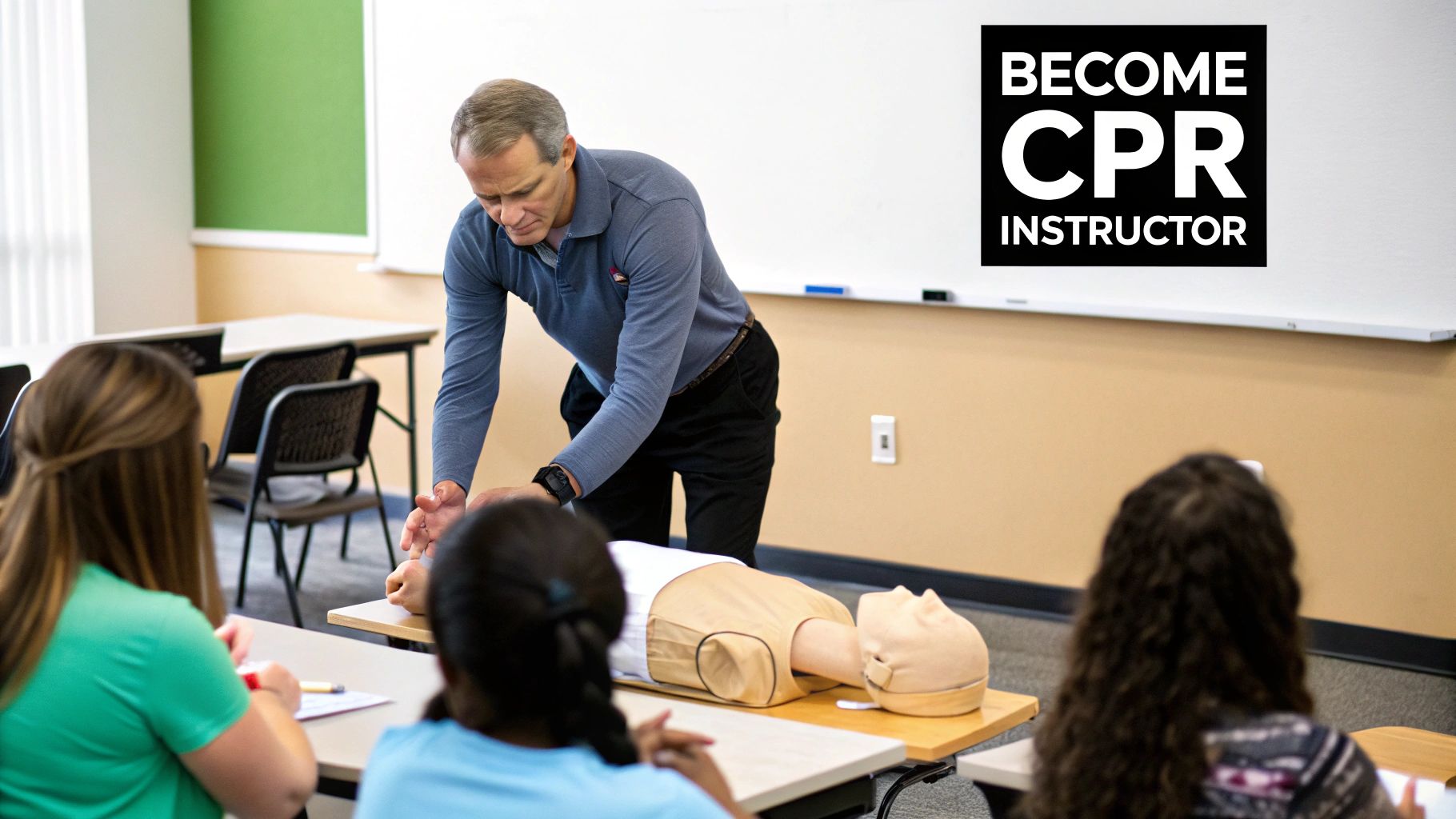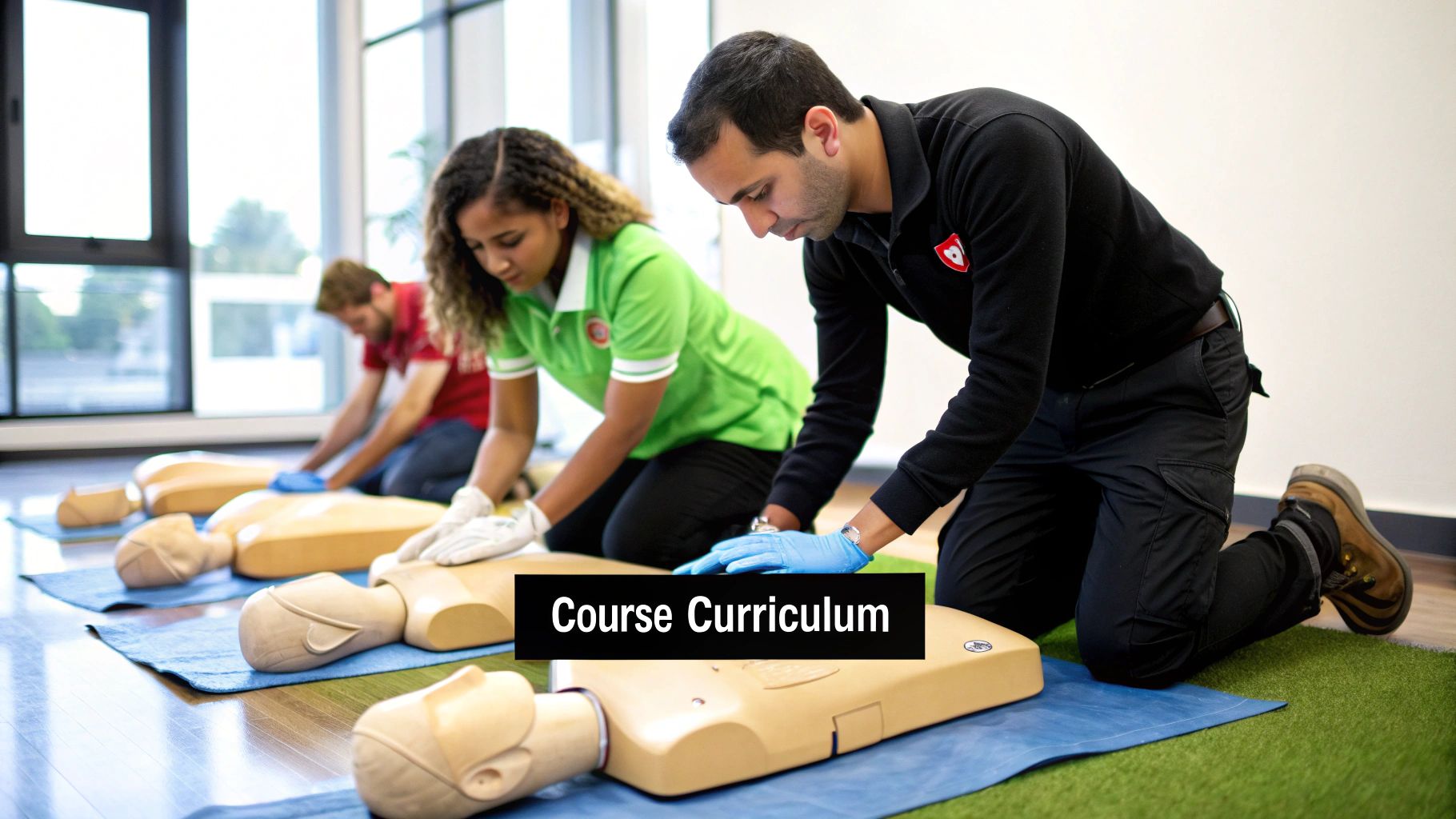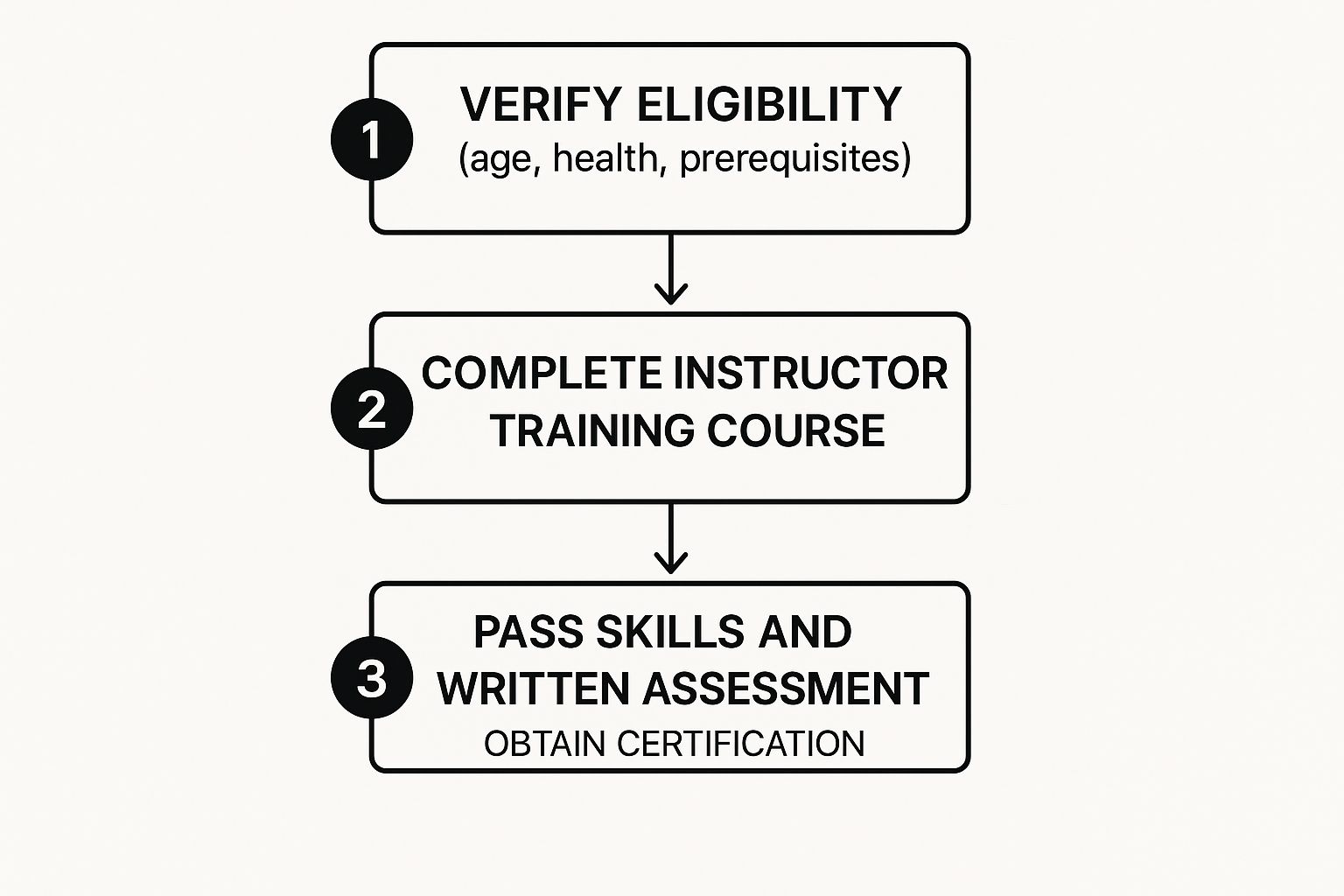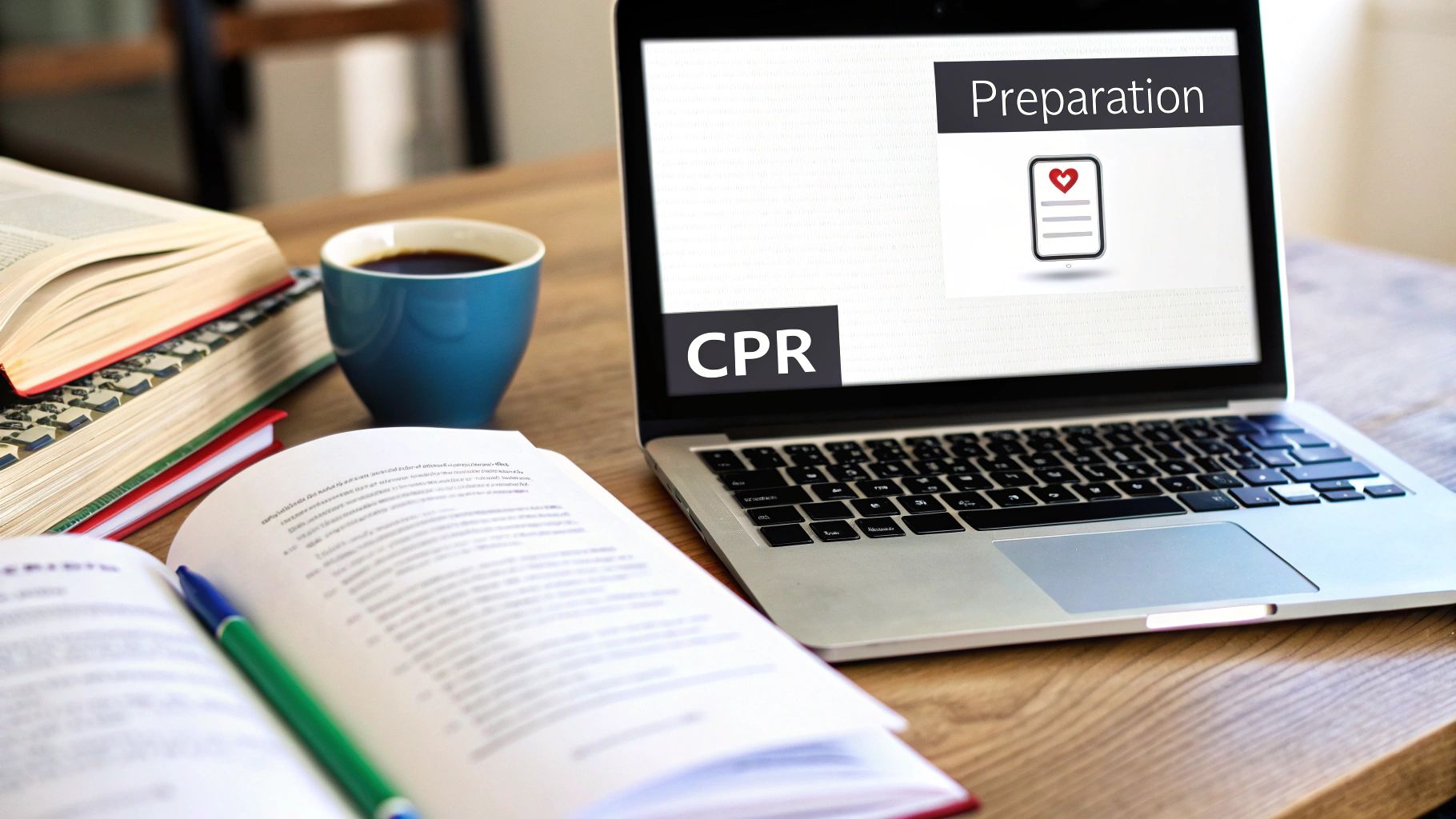Deciding to become a CPR instructor is a pretty big deal. It’s about more than just tacking a new certification onto your resume—it’s a commitment to giving people in your community the skills to actually save a life. A cpr instructor certification is your ticket to teach others how to act with confidence during a cardiac emergency, turning regular folks into everyday heroes.
Why Becoming a CPR Instructor Matters

Honestly, stepping into the role of a CPR instructor is one of the most rewarding paths you can take. This decision goes way beyond personal achievement; it has a direct, real-world impact on public health. Every single class you teach makes your community stronger and more resilient, one student at a time. The hard truth is that sudden cardiac arrest can strike anywhere, and survival often comes down to immediate action from a bystander.
This guide is your personal roadmap. I've laid it all out to walk you through everything you need to know, from picking the right training program and navigating the certification process to actually using your new skills in different professional settings. Think of it as a detailed game plan, full of practical advice and insights I've picked up over the years to help you succeed.
The Value You Bring as an Instructor
Getting certified isn't just about learning how to teach a class. It's about becoming a leader and the go-to resource for emergency preparedness. You'll often be the first person individuals and companies turn to when they want to build their safety skills. Your job is to make the process less intimidating and build real confidence.
Here’s what you truly bring to the table:
- Empowerment: You give people the confidence and skills to act decisively when every second is critical.
- Community Safety: You directly strengthen what experts call the "chain of survival"—the crucial, early links that save lives.
- Professional Growth: The skills you pick up, from public speaking to advanced resuscitation knowledge, make you a huge asset in any workplace or community group.
The real mission of a CPR instructor is to turn fear and uncertainty into skilled, confident action. You aren't just teaching techniques; you're building a network of first responders within families, workplaces, and neighborhoods.
Ultimately, your goal is to learn not just what to do, but why every step is so important. This deeper understanding is what will make you a truly effective and inspiring teacher. You’ll be ready to handle tough questions, adapt your teaching style, and make sure every student leaves your class ready to make a difference. Let's get started.
Meeting the Prerequisites for Certification
Before you can even think about leading a classroom, every major certifying body—like the American Heart Association (AHA) and the American Red Cross—has a list of non-negotiable prerequisites. Think of these as the bedrock of your instructor career. They aren't just hoops to jump through; they exist to make sure every single instructor has truly mastered the skills they'll be passing on.
The single most important requirement is holding a current, valid provider-level certification in the specific discipline you want to teach. Want to become a Basic Life Support (BLS) instructor? You must first have a valid BLS Provider card. It's that simple. You can't effectively teach what you haven't recently perfected yourself. Your provider card is the proof that you're up-to-date on the latest science and can perform every skill at an exemplary level.
Age and Foundational Skills
Most organizations require you to be a certain age. The AHA, for instance, requires instructor candidates to be at least 16 years old to teach basic courses like Heartsaver, and 18 years old to become a BLS Instructor. This isn't arbitrary—it ensures a level of maturity and life experience that's vital when you're managing a class and conveying the seriousness of the subject.
But it’s about more than just your age. You have to show up with impeccable hands-on skills. Your instructor course isn't where you re-learn CPR; it's where you learn how to teach it. You're expected to walk in the door with your skills already polished to a high shine.
The core idea is simple: You must be a model of excellence. Your students will mirror your technique, so your compressions, breaths, and AED use must be flawless before you step to the front of the classroom.
For a deeper look into the full journey, our guide on how to become a CPR instructor covers the entire process from start to finish.
Comparing Key Organizational Requirements
While the main prerequisites are pretty similar across the board, you'll find slight differences between the major players. Understanding these nuances can help you pick the path that fits your career goals best.
Let's break down what the two most recognized organizations typically ask for:
American Heart Association (AHA)
- Provider Card: You'll need a current AHA BLS Provider card.
- Age: Must be at least 18 to become a BLS Instructor.
- Skill Proficiency: You have to demonstrate near-perfect BLS skills before you're even accepted into an instructor course.
- Course Completion: You're required to complete the online "Instructor Essentials" course for your chosen discipline before attending the hands-on classroom portion.
American Red Cross (ARC)
- Provider Card: Requires a current ARC basic-level certification (like Adult and Pediatric First Aid/CPR/AED).
- Age: You must be at least 16 years old on the last day of the instructor course.
- Online Introduction: You'll need to complete an online introduction to their specific instructor course.
- Skill Assessment: Candidates must pass a "pre-course skills session" to prove they're competent before moving on to the actual instructor training.
In the end, both the AHA and ARC are shooting for the same goal: producing instructors who are not only skilled rescuers but are also capable of creating a positive and effective learning environment. Looking over these prerequisites is your first real step in making sure you're ready for this rewarding role.
Choosing Your CPR Instructor Training Program

Once you've confirmed you meet all the prerequisites, your next big decision is picking the right training program to earn your CPR instructor certification. This choice is about more than just getting a card in the mail. It's about aligning with an organization whose standards, teaching philosophy, and reputation actually fit your career goals.
Let's be clear: not all instructor courses are created equal. The organization you certify with will heavily influence your teaching style and the opportunities that open up for you.
In the U.S., the two giants in this space are the American Heart Association (AHA) and the American Red Cross (ARC). Both are highly respected, but they tend to serve slightly different crowds. If you're planning to teach in healthcare, clinical settings, or corporate environments where compliance is everything, the AHA is almost always considered the gold standard.
The American Heart Association Gold Standard
The AHA’s reputation is built on a rock-solid, science-first foundation. Its guidelines come directly from the International Liaison Committee on Resuscitation (ILCOR) and are constantly updated with the latest evidence in cardiovascular care. This rigorous commitment to science is exactly why so many hospitals, dental offices, and medical professionals will only accept AHA certifications.
An AHA instructor course typically uses a blended learning model, which looks something like this:
- Online Essentials: You’ll kick things off with a self-paced online module. This covers teaching methods, official AHA policies, and course-specific information.
- In-Person Session: This is where the real work happens. You'll put theory into practice by leading mock classes, coaching "students," and proving your own skills under the direct supervision of experienced Training Center Faculty.
The true power of an AHA certification is its global reach and unwavering commitment to evidence-based practice. When you teach an AHA course, you're not just sharing skills—you're delivering a curriculum trusted by medical professionals all over the world.
For those serious about a teaching career, pursuing additional credentials can be a smart move. Many aspiring instructors look into a formal Certificate in Education and Training to build a strong foundation in the teaching methods that are crucial for any instructional role, including CPR.
What It Means to Align with a Training Center
Becoming an instructor isn't a one-and-done deal. After you pass your course, you have to formally align with an authorized AHA Training Center (TC). Think of this as your home base for support, class materials, and quality assurance.
Your TC is the entity that provides ongoing monitoring, issues your students' certification cards, and keeps you in the loop about any guideline changes. Honestly, choosing the right TC is just as important as choosing the program itself. If you're weighing your options, our guide on choosing the right CPR training provider offers some valuable insights.
The American Heart Association's influence is massive. As of 2025, it operates through more than 3,500 authorized Training Centers across 92 countries. This vast network makes it one of the most powerful forces in resuscitation education, training over 22 million people around the globe each year. This affiliation doesn't just give you credibility; it connects you to a huge support system.
From Training Day to Your First Class
Stepping into an instructor course is a whole new ballgame. It’s a huge shift from being the student who’s just trying to perfect their own technique. Now, you’re learning how to spot common mistakes, give feedback that actually helps, and manage a classroom full of people with different learning styles. This is really where the rubber meets the road on your journey to earn a cpr instructor certification.
The whole process can feel a bit overwhelming, but it’s actually a pretty logical path. Think of it in a few key phases, from getting your prerequisites in order to finally teaching your own students.

As you can see, it’s a structured journey. It all starts with making sure you're eligible and then moves into the core instructor training, where you’ll be evaluated on both what you know and how well you can teach it.
To give you a clearer picture, here’s a quick breakdown of what that journey looks like from start to finish.
CPR Instructor Certification Journey at a Glance
This table maps out the core stages, showing how each step builds on the last to get you ready for the classroom.
Acing Your Skills and Written Exams
Your instructor course wraps up with two critical assessments: a skills evaluation and a written exam.
The written test isn't about memorizing every little detail. It covers the course material, effective teaching strategies, and official program rules. It’s usually open-book for a good reason—the goal is to make sure you know exactly where to find the official answers when a student asks a tough question in one of your own classes.
The skills evaluation is where you really get to prove your stuff. A senior instructor or a member of the Training Center Faculty will watch you demonstrate the core CPR and AED skills. They’re looking for more than just perfect technique. They want to see that you can coach, correct a student’s form, and explain things clearly.
Pro Tip: During your skills check-off, narrate what you're doing. Explain why you're placing your hands a certain way or why a specific step is so critical. It shows you understand the material on a much deeper level than just going through the motions.
Once you pass, the next big step is finalizing your alignment with an authorized Training Center. This is what gives you the green light to actually teach courses and issue certification cards. Your Training Center becomes your go-to resource for course materials, quality assurance, and staying up-to-date on any changes.
Beyond Certification: Your First Class and Ongoing Growth
Getting your instructor card is just the beginning. Your first few classes are where you’ll truly learn what it means to be an instructor. You'll quickly figure out how to read a room, manage the pace of your lesson, and adapt your teaching style on the fly. Confidence comes from doing, so don't hesitate to jump in and get started.
Maintaining your certification means you have to stay sharp. Most instructor credentials are valid for two years, and renewal typically involves a few key things:
- Teaching a minimum number of courses to stay active.
- Completing any required updates when guidelines change.
- Being successfully monitored by your Training Center Faculty.
This commitment is more vital than ever. Cardiovascular disease remains the leading cause of death worldwide, creating a massive demand for high-quality CPR training. The American Heart Association's global network, which includes over 30,000 instructors and training centers, highlights just how urgent this need is. You can learn more about the AHA's international efforts and their work in fighting this global health crisis. As an instructor, you become a critical part of that worldwide solution.
The Critical Role of Instructors in the Workplace

Getting your CPR instructor certification isn't just about learning to teach. It's about becoming a genuine safety asset, especially inside the workplace. So many companies have what I call a "preparedness gap"—that huge space between how often emergencies actually happen and how few people are ready to act.
As a certified instructor, you're the one who can finally close that gap. You become the catalyst that shifts a company’s safety culture from simply reacting to emergencies to proactively preparing for them. Offering convenient, on-site training removes one of the biggest roadblocks for busy professionals. Your hands-on presence makes safety real and immediate, not just another policy memo that gets filed away and forgotten.
Bridging The Workplace Preparedness Gap
The need for skilled instructors in corporate and industrial settings is more urgent than you might think. The data tells a pretty stark story. In the United States alone, there are around 10,000 cardiac arrests in the workplace every single year.
Despite this, about 50% of employees can't even find an AED at their job. A survey of 2,000 employees found that a staggering 55% reported their employer offers no first aid or CPR training at all. These aren't just abstract numbers; they represent thousands of missed chances to save a life. One dedicated instructor can completely flip that dynamic for an entire organization.
From Policy To Practice
Your impact goes way beyond a single class. As an on-site expert, you can spearhead emergency drills, make sure AEDs are not only available but also visible and maintained, and answer the day-to-day questions that build team-wide confidence. You turn safety from a binder on a shelf into a living, breathing part of the company culture.
This creates a powerful ripple effect:
- Reduced Panic: Trained employees are far less likely to freeze up when something goes wrong.
- Faster Response Times: When people know their roles and where the equipment is, they act faster and more effectively.
- Improved Team Cohesion: Practicing these skills together builds trust and a shared responsibility for each other's well-being.
An instructor doesn't just teach CPR; they build a small army of first responders. You empower every single employee with the knowledge that they can be the one to make the difference for a coworker in crisis.
Thinking about the bigger picture, CPR instructors are a huge contributor to both workplace safety and employee wellness, aligning with many core corporate wellness program benefits. Your certification makes you an invaluable asset, proving you can protect a company’s most important resource—its people. If you're looking to build out a robust safety program, we have some great tips for implementing and maintaining effective CPR training programs in the workplace in our detailed guide.
Common Questions About Instructor Certification
Thinking about becoming a CPR instructor? It’s a big step, and it’s totally normal to have questions about the time commitment, how much you can earn, and what it really takes to be successful.
Let’s dig into some of the most common questions I hear from aspiring instructors. My goal is to give you the clear, straightforward answers you need to decide if this is the right path for you.
How Long Does It Take to Get Certified?
This is probably the number one question I get, and the answer usually surprises people: you can get fully certified in just a few weeks.
That timeline covers everything—from finding and enrolling in an instructor course, completing any online pre-work, and attending the in-person training. The hands-on portion itself is typically just a day or two. The final piece of the puzzle is aligning with a Training Center, which officially activates your instructor status.
Can I Make a Living as a CPR Instructor?
Absolutely. I've seen many people build rewarding full-time careers or very profitable side businesses from their certification. It really comes down to a few key things: how you market yourself, the demand for training in your local area, and which advanced courses you get certified to teach.
You’ve got options. You can work for an established training company or strike out on your own and launch your own business.
The most successful instructors I know are not only passionate about teaching life-saving skills but are also smart entrepreneurs. They spot a need in their community—whether it’s for local dental offices, childcare centers, or construction crews—and they fill it with engaging, high-quality training.
How Often Do I Need to Renew My Certification?
This is a critical one to keep on your radar. Most major instructor certifications, including those from the American Heart Association, are valid for two years. Staying active is more than just paying a fee; it's an ongoing commitment.
To renew, you’ll typically need to:
- Teach a minimum number of classes to show you’re actively instructing.
- Complete an official update covering any new CPR science or guideline changes.
- Be monitored and have your teaching skills approved by your Training Center Faculty.
Falling behind on these requirements can mean starting the whole process over. For a deeper dive, our article on employee CPR certification renewal has some great information that also applies here.
AHA vs. Red Cross: What Is the Real Difference?
Both are fantastic, highly-respected organizations, but they tend to serve different markets. Think of it this way: the AHA is the gold standard in healthcare. If you're teaching in hospitals, clinics, or to medical professionals, its deep, science-first approach is what employers demand.
The American Red Cross, on the other hand, has a very strong foothold in community and general workplace training. Your choice really boils down to who you want to teach. If your target audience is doctors, nurses, or EMTs, the AHA is almost always the way to go.
At Ready Response, we don't just hand out certifications; we build confident responders and empower instructors to succeed. Whether you're ready to take your first class or become a certified instructor yourself, we offer the expert-led training and ongoing support you need. Explore our courses and instructor programs today.
